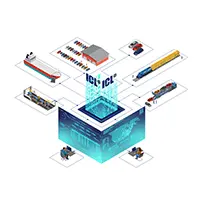Media Sharing
Get More from ICL Directly to Your Inbox



Premier visibility for railcar tracking & management
Trusted 3PL expertise for finished vehicle logistics
End-to-end visibility for finished vehicle shippers
Turnkey solution to manage your yard operations
Optimize or design your transportation network with ease
Streamline your load for maximum efficiency
Even more custom service solutions to support all your logistics needs
We're proud to be a leader in product visibility and invoice auditing solutions throughout the logistics supply chain. Learn more.
Looking to join our team of award winning experts? Check out our open positions now.
We want to hear from you! Get in touch with us today.
For the fine print on our privacy policy, cookies and data, & more.
See how we keep your data safe with certified security practices, secure systems, and constant monitoring.

ICL’s powerful VLMS system is designed to provide automotive manufacturers (OEMs) and logistics service providers (LSPs) with seamless operations, predictable transportation utilization, real-time information, and on-time delivery of new vehicles. Based on the Vehicle Logistics Management System (VLMS), ICL has developed different modules for the challenges of vehicle logistics. All modules are designed to integrate seamlessly and support all challenges of logistics teams. Instead of managing a dozen or more vendors, ICL becomes the single point of contact, reducing complexity and administrative costs. Whether through real-time APIs, web services, or traditional EDI, ICL can capture data from any source and support any customer’s requirements.
Currently, ICL is connected to over 160 different logistics service providers in the automotive industry, setting the benchmark for exchanging and digitizing finished vehicle logistics information. Most finished vehicle logistics providers relate to ICL, making us the industry standard for facilitating data connectivity between manufacturers and logistics partner.
To offer complete visibility of all vehicles in the transportation process, ICL developed the Automated Asset Tracking System, a cornerstone of the VLMS suite of web-based solutions. The Automated Asset Tracking Module provides multi-modal tracking, status reporting, and metrics.

Manufacturers can now track the status of all vehicles in the distribution process across all modes of transport, capturing and reporting updates in status and location in real-time. It also enables you to calculate estimated arrival times for all units in transport, updating during transit. The system provides access to a wide range of exception reports that are continuously updated, providing instant visibility on any problems or delays. Users can also manage the performance of carriers and other supply chain partners using ICL’s performance reporting tools, which provide detailed performance information by origin, route, or vendor. The transportation industry is defined by inconsistent standards and practices, creating operational inefficiencies that add cost and complexity to our customers’ transportation networks. The goal is to bring order to this process and become the preferred communication method between automobile manufacturers and logistics partners.
One of the main tasks of the VLMS system is to predict the estimated time of arrival (ETA- Estimated Time of Arrival) of new vehicles. This allows the OEM’s logistics teams to inform dealers of the arrival time of the vehicles and act in time in case of any delays or incidents.
The logic of ETAs is vastly different; the problem with vehicle distribution visibility is not a lack of data; it’s the weakness of the considerable amount of data moving through the supply chain and passing into the system. To make an accurate prediction of arrival time, it is necessary to utilize and analyze this massive amount of data. Also to consider is static ETAs that are based on historical conditions. However, these do not consider actual operational events. GPS-based solutions are suitable for visibility (the vehicle on the map). Still, they do not include a chain of custody reporting (CoC) or updating the commercial status of the vehicle. Accurate estimated vehicle arrival times require a system that centralizes all these inputs and predicts an estimated arrival time based on each trip segment. ICL’s ETA can be configured to various vehicle factors affecting the ETA at the VIN level. With 30 years of experience to date, our award-winning ETA process is the most critical component of our VLMS system. We know that the vehicle logistics of manufacturers are different, and each OEM needs its formula. This involves processing vast amounts of data provided by the transportation company.
What Drives Our Success?
Power Of Technology To Drive Efficiency!

As part of the VLMS system ICL offers to the European market, OEMs benefit from automated tracking of vehicles and automated invoice auditing and approval. The Electronic Invoice Audit module is a reliable and effective way to manage transportation costs while automakers only pay their suppliers for approved orders. Currently, invoices for new car shipments are manually reviewed, processed, prone to errors, and only a tiny portion of invoices can be verified. When the manual effort is pervasive, random checks are performed. Inaccurate invoices are created, or duplicate payments are initiated. For each vehicle, manufacturers receive detailed information on costs to evaluate and maximize the performance of the logistics provider. Payment status information is synchronized between the two systems. The VLMS system can also be linked to the OEM’s ERP system.
The benefits for the automotive manufacturer of the Electronic Invoice Audit Module:
Objectives within the logistics sector set to reduce carbon emissions have been established: By 2030, the EU aims for 30m zero-emission cars on Europe’s roads and 80,000 zero-emission trucks. Logistics professionals (OEMs and LSPs) will need an automated and standardized system to measure, report, and reduce their outbound logistics (transportation and storage) emissions. At ICL, we believe emissions reporting will become another metric on the outbound logistics scorecard, along with cost, transit time, and quality. We are uniquely positioned to collect the additional data needed in one central place. Further, the data feeds are already set up between parties, and there will be less effort for the LSPs to set up the additional data to be sent to ICL versus a new integration with a new provider.
Generic transportation calculators that can incorrectly calculate vehicles’ emissions are overstating and lacking VIN-level detail. ICL’s emissions calculations are specialized for the unique needs of finished vehicle logistics. ICL’s emissions calculator can provide accurate, VIN-level detail for the OEM and the LSP based on the collected data to support tracking and trace visibility. ICL already offers accurate and detailed transit time, cost, and quality calculations to the OEM and LSP. In addition, an accurate VIN-level emissions calculation supports the VLMS platform by simplifying and reducing non-added value work, being a global solution, resolving OEM critical pain points and challenges, and providing the additional KPI measurement and management. Currently, we are members of the AIAG and ECG industry working groups, which address GHG standards for unique FVL needs.
ICL consistently finds ways to solve our customers’ transport/supply chain problems, and as our customer’s issues change, our product offerings need to meet those needs. Contact ICL for more information on redefining your logistics process.


